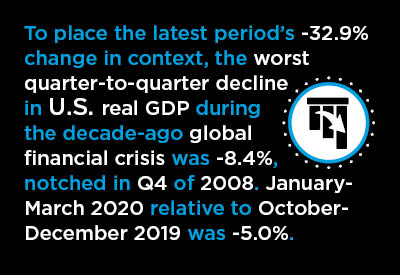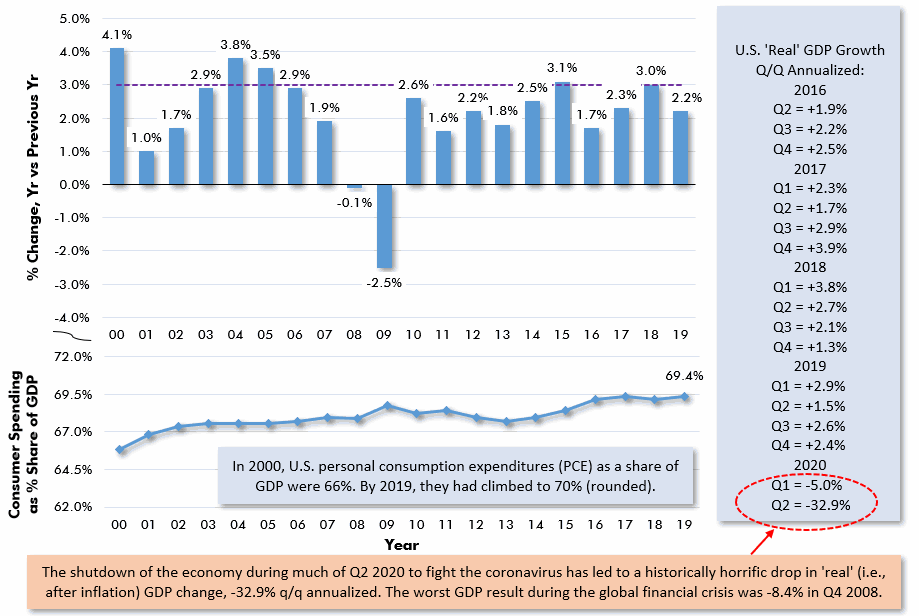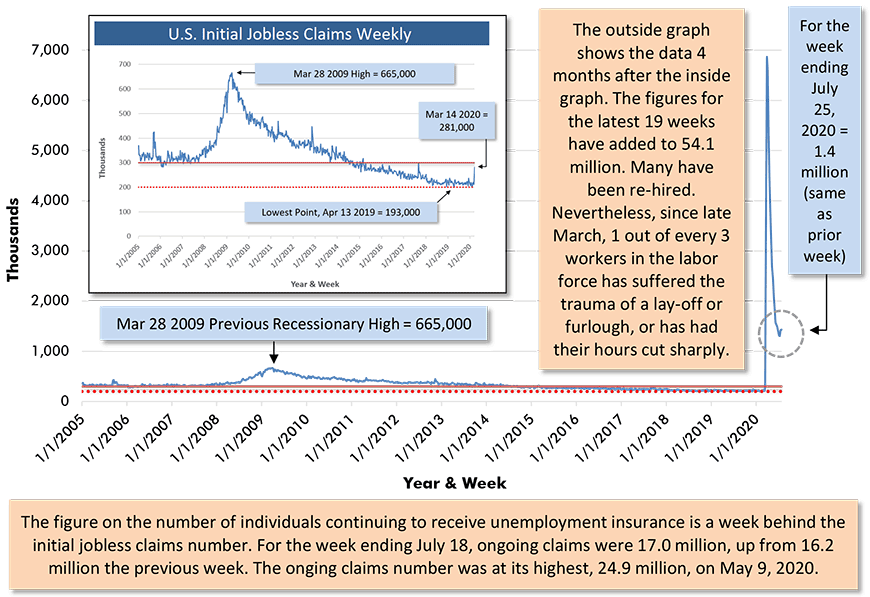Mid-summer 2020 will forever be known as a historic time for U.S. economic data releases. On this date, July 30th, the Bureau of Economic Analysis (BEA) has published its estimate of Q2 versus Q1 gross domestic product (GDP) change, annualized (i.e., extended for a full year), and it’s a searing drop of -32.9%.

Dealing with the coronavirus outbreak has exacted a terrible toll. Over the past four months, one-third of the U.S. labor force has been laid off, furloughed or suffered drastic reductions in pay and hours worked. And now it’s been revealed that national output was cut by one-third from April-June versus January-March. Not to be forgotten, January-March 2020 relative to October-December 2019 was also in the red, -5.0%.
The most dramatic changes in GDP line items in the BEA’s ‘Advance Estimate’ report for Q2 2020 were as follows: ‘personal consumption expenditures’, -34.6% q/q annualized; consumer expenditures on services, -43.5%; investment in nonresidential structures, -34.9%; investment in residential structures, -38.7%; exports of goods and services, -64.1%; imports of goods and services, -53.4%; and ‘final sales of domestic product’, which omits the negative effects of the foreign trade shortfall, -29.3%.
From the investment figures above, it’s apparent that construction activity did not escape unscathed despite having the advantage of being judged ‘essential’ and allowed to proceed nearly everywhere in America, while other sectors were in lockdown.
To place the latest period’s -32.9% change in context, the worst quarter-to-quarter decline in real GDP during the decade-ago global financial crisis was -8.4%, notched in Q4 of 2008.
The BEA’s ‘Second Estimate’ of 2020’s Q2 change is scheduled for August 27th release. Given how difficult it has become to stay on top of events as they are unfolding in real time these days, more and larger revisions than usual may be forthcoming.
Q3 and Q4 of this year will be hard pressed to deliver recoveries that limit full-year 2020’s decline versus full-year 2019 to a range of -5.0% to -7.0%.

Chart: ConstructConnect.
An Unfortunate Uptick in Initial Jobless Claims
Springing up on the Internet at the same time (8:30 am EDT) as the GDP report was the usual Thursday morning ‘initial jobless claims’ story. If one was hoping to find comfort from the second data set, alas it was not to be. There was no counterbalancing good news from the unemployment insurance statistics.
Weekly initial jobless claims may have nosedived from nearly 7.0 million in early spring to 1.3 million for two weeks in early July, but in the past two weeks they have risen again to 1.4 million.
The spread of the coronavirus has not been halted by hot weather. Moreover, COVID-19 has moved from northern climes to the south and the west of America. State governments that were eagerly re-opening have been forced to rethink their positions.
The consequence for consumer spending, and thereby GDP, of sticky initial jobless claims numbers is being rendered more dire by the end-of-July expiry of the extra $600 per week in benefits. Congress is having trouble agreeing on a compromise relief package.

Chart: ConstructConnect.
Revisions to Past Data and Annual Average GDP Growth Rates
The BEA has revised its GDP estimates going back several years.
During the past 20 years, and according to the updated statistics, there have been five years when annual GDP growth reached +3.0% or more. There were an additional two years when it was at +2.9% (see Graph 1).
From 2000 to 2019, a period of twenty years, America’s average annual real GDP increase was +2.1%. If the recession years of 2008 and 2009 are left out, the annual average was +2.5%.
For the ten years from 2010 to 2019, average annual GDP growth was +2.3%.
Since 1947 (i.e., Beginning of BEA data)

Chart: ConstructConnect.
Alex Carrick is Chief Economist for ConstructConnect. He has delivered presentations throughout North America on the U.S., Canadian and world construction outlooks. Mr. Carrick has been with the company since 1985. Links to his numerous articles are featured on Twitter @ConstructConnx, which has 50,000 followers.










Recent Comments
comments for this post are closed